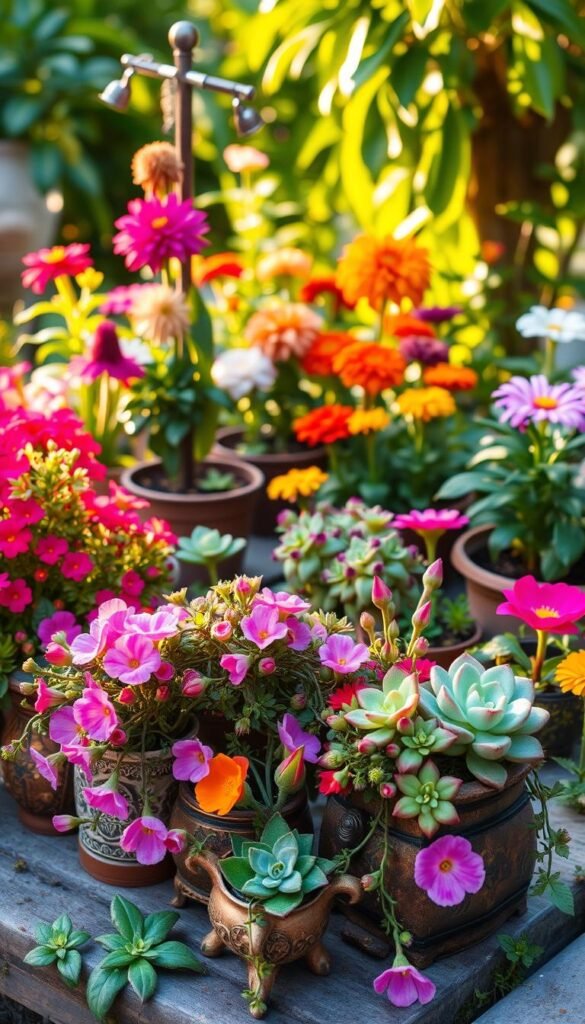Want to transform your patio, balcony, or windowsill into a lush retreat? You don’t need acres of land to create stunning green spaces. With clever designs and strategic plant choices, even the tiniest areas can burst with color and life. This approach lets you experiment with seasonal blooms, textures, and arrangements without overwhelming your schedule or space.
Why does this method work so well? It gives you complete control over your environment. You can easily adjust sunlight exposure, water levels, and soil quality for each pot. Renters love how portable these setups are, while urban gardeners appreciate their ability to turn concrete corners into vibrant oases. For inspiration, explore these container gardening ideas that maximize visual appeal.
Choose plants that pop with color or trail gracefully over edges to add depth. Group pots at varying heights to create dimension, making your area feel larger than it is. Best of all? You’ll spend less time weeding and more time enjoying your personalized paradise.
Whether you’re growing herbs for your kitchen or cultivating a floral showcase, this flexible style adapts to your goals. Ready to rethink what’s possible in limited spaces? Let’s dig into the creative possibilities waiting at your fingertips.
Discovering the Benefits of Mini Container Gardens
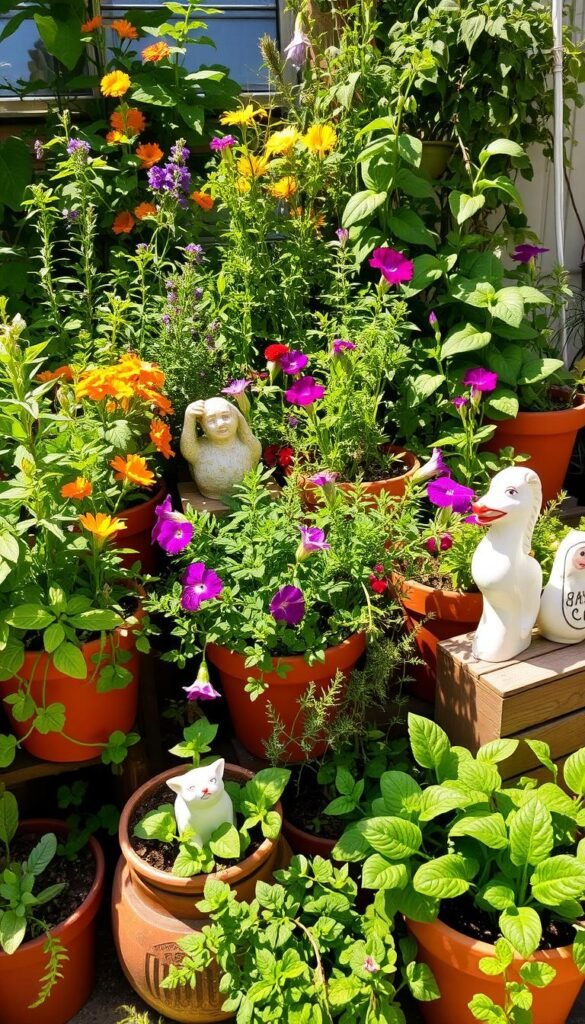
Unlock the hidden potential of compact areas with smart container strategies. These pint-sized plant arrangements let you reimagine balconies, entryways, or even staircases as thriving green zones. Unlike traditional beds, they adapt to your lifestyle while delivering surprising advantages.
Space-Smart Growing Solutions
Small containers give you command over your plants’ environment. You can customize soil mixes for each species and prevent waterlogging through precise drainage control. This tailored approach helps sensitive herbs and delicate blooms thrive where they might struggle in open ground.
Seasonal flexibility becomes your superpower. When frost threatens, simply carry tender specimens indoors. Rotate sun-loving varieties to chase light patterns throughout the day. One gardener transformed their north-facing fire escape using this method, tripling their harvest of fresh basil and cherry tomatoes.
Design Tricks for Maximum Effect
Clever color choices create visual magic in tight quarters. Cool-toned blooms like lavender push boundaries outward, while warm red geraniums add cozy intimacy. Try pairing trailing ivy with upright snapdragons in a single pot – the contrast adds depth without clutter.
Maintenance stays simple when everything’s within arm’s reach. You’ll spend minutes watering instead of hours weeding. For inspiration on combining hues, explore these vibrant container arrangements that balance form and function perfectly.
Selecting the Perfect Containers for Your Space
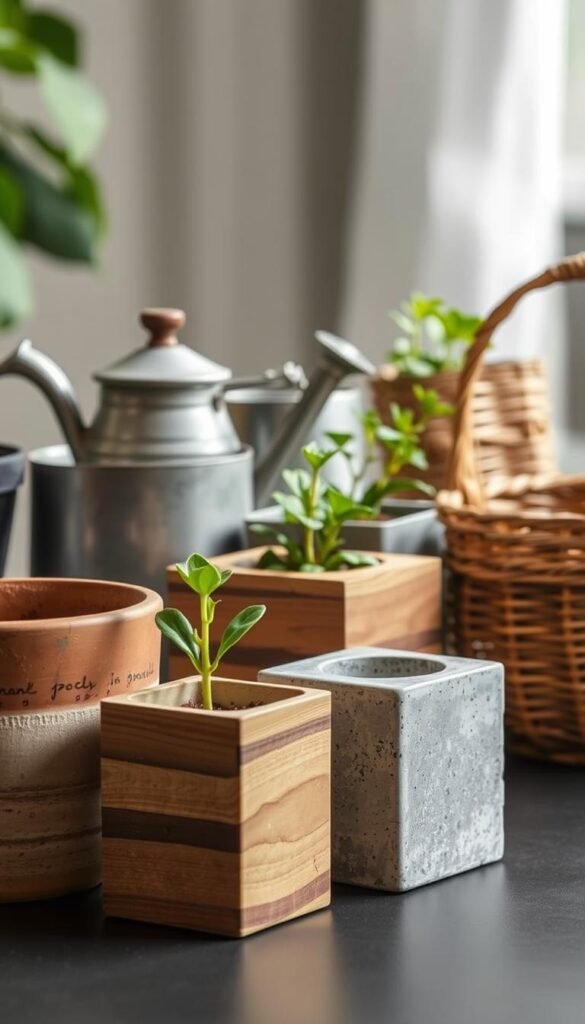
Your container choices shape your garden’s success as much as the plants themselves. The right material balances aesthetics, function, and your local climate. Let’s break down what works best for different needs.
Exploring Different Materials and Styles
Lightweight plastic pots excel on balconies where weight matters. They keep soil moist longer—ideal for thirsty annuals. But anchor them well; windy spots might tip them over.
Clay or terracotta containers let roots breathe. They’re perfect for lavender or succulents that hate wet feet. Just water more often in hot weather since they dry quickly.
For a polished look, ceramic planters deliver. Their heft stabilizes tall plants in breezy areas. Line them with plastic to protect finishes if using outdoors year-round.
| Material | Best For | Considerations |
|---|---|---|
| Plastic | Balcony herbs, shade plants | Add rocks to base for stability |
| Clay | Cacti, Mediterranean herbs | Water 20% more frequently |
| Ceramic | Patio focal points | Use saucers to protect surfaces |
| Metal | Modern designs | Line with insulation in summer |
Upcycle old items like colanders or baskets for quirky charm. Just drill drainage holes! For expert tips on choosing the right containers, match your picks to each plant’s water and space needs.
Wooden boxes bring rustic warmth. Cedar resists rot naturally—great for edible gardens. Pair deep pots with carrots or tomatoes, shallow ones with lettuces.
Planning Your Garden Layout for Visual Appeal
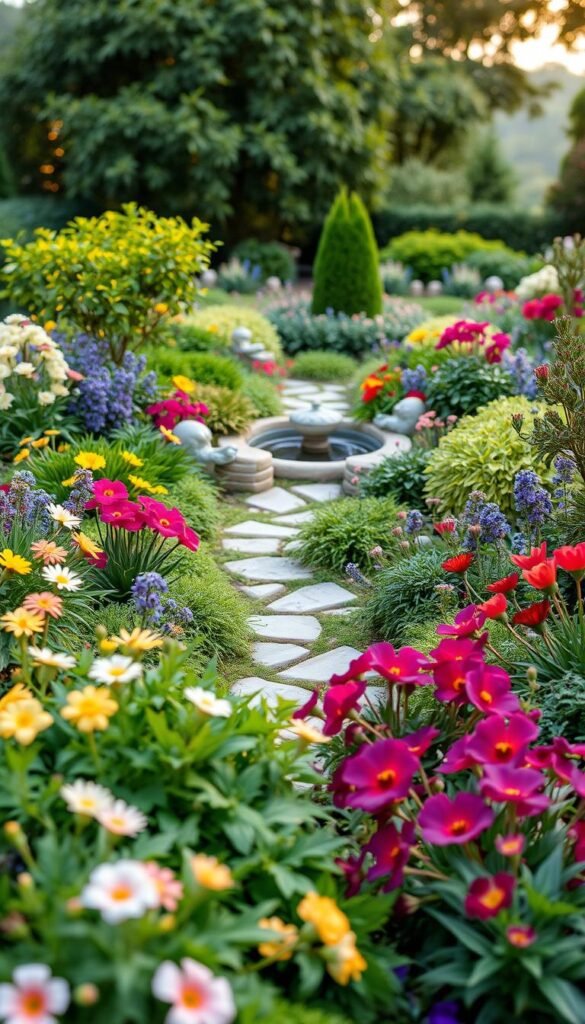
Transform cramped corners into eye-catching retreats by rethinking your layout strategy. Instead of lining edges with pots, place bold focal points in unexpected spots. A towering yucca in a sleek planter near your entryway, for example, instantly draws attention while framing your space.
Use the rule of threes to group containers. Odd numbers feel more natural—try three varied-height pots with complementary plants. Tall grasses in the back, mid-sized begonias in the middle, and trailing ivy up front create instant depth. This trick makes tight areas appear expansive.
Curved pathways work magic in narrow yards. Stepping stones winding between clusters of hostas and ferns invite exploration. You’ll guide visitors past your best displays while making the area feel spacious. Add a tiny bench beside a bubbling fountain to carve out cozy nooks.
Sync colors with your home’s exterior for harmony. Match terracotta pots to brick accents or pick blue blooms that echo shutters. Rotate seasonal stars like mums in fall and pansies in spring to keep your design fresh year-round.
Position sun-loving plants where light lingers longest. Track shadows throughout the day—morning rays suit delicate impatiens, while afternoon heat fuels vibrant lantana. Smart placement ensures every container shines in its prime time.
Mini Flower Garden Projects: Small Containers, Big Impact in Action
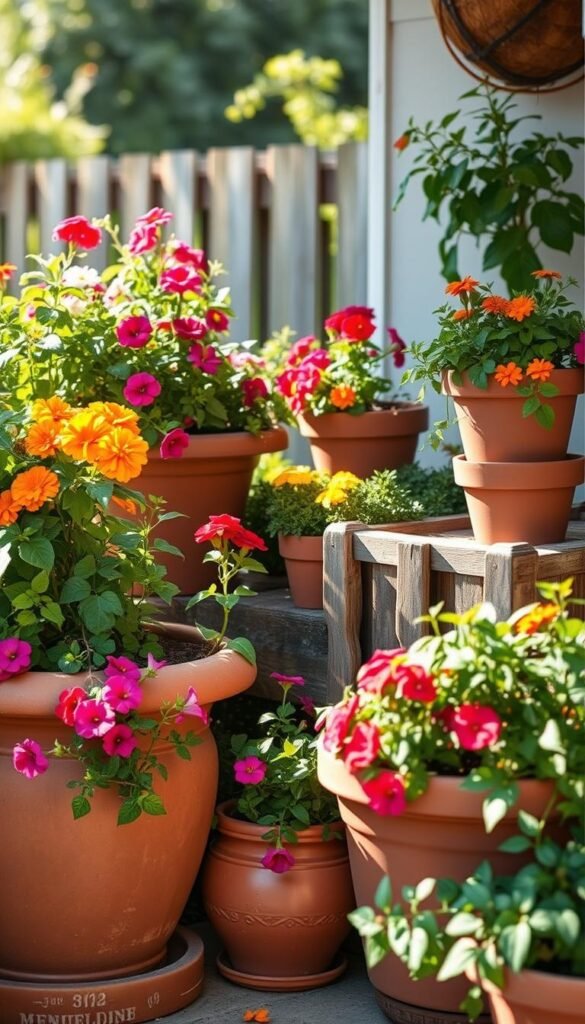
Ready to turn concepts into living masterpieces? These hands-on approaches help you craft eye-catching arrangements that thrive in any setting. Let’s explore techniques that deliver professional results with everyday effort.
Effortless Design Formulas
Start with shade-loving caladiums for instant drama. Their rainbow-striped leaves light up dim corners while needing minimal care—just keep soil slightly moist. Pair them with silver artemisia for texture contrast that lasts all season.
Try single-variety magic with petchoas. These hybrid blooms offer bold color saturation in fiery oranges or deep purples. Plant three in a 14-inch pot for a big impact that rivals mixed arrangements.
- Layer heights: Use golden creeping Jenny beneath upright coleus
- Tropical escapes: Combine red mandevilla with pink hibiscus
- Low-light stars: Torenia thrives under trees with red coleus
Proven Combinations That Work
Portland resident Mia transformed her bleak balcony using our tropical mix formula. “The majesty palm anchors the display,” she shares. “Neighbors keep asking if I hired a designer!”
For continuous blooms, pair Easy Wave petunias with scarlet cordyline. This duo flourishes in full sun and handles dry spells like champions. Remember: proper drainage prevents root rot—beginners should test soil moisture weekly.
Chicago gardener Carlos achieved his lush patio look using layered planters. “Trailing calibrachoa softens the edges,” he notes. “The peach flowers complement my brick walls perfectly.”
Mixing Ornamentals and Edibles for a Vibrant Look
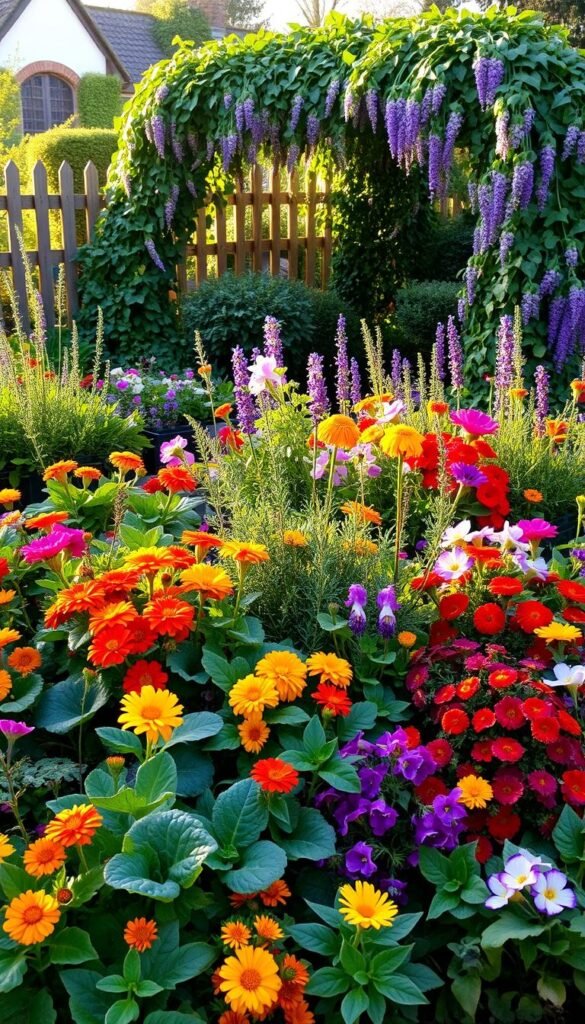
Who says veggies can’t be pretty? Combine tasty vegetables with showstopping flowers to create living rainbows that feed both your stomach and soul. This approach lets you maximize every inch while keeping your space productive and eye-catching.
Try pairing cherry tomatoes with marigold ‘Tiger Eyes’ – their golden blooms deter pests while adding sunset hues. Leafy greens like red lettuce pop alongside purple cosmos, creating edible art. For texture contrast, nestle frilly parsley between pansies’ cheerful faces.
Creating Harmonious Color Schemes
Choose edible plants with ornamental flair. Purple kale varieties like ‘Redbor’ offer dramatic foliage, while flowering herbs like borage sprinkle blue stars among your peppers. Follow these winning combinations:
| Plant Pairing | Benefits | Color Impact |
|---|---|---|
| Strawberries + Yarrow | Attracts pollinators | Red fruits + white blooms |
| Basil + Zinnias | Repels mosquitoes | Green-purple leaves + bright petals |
| Dwarf Carrots + Alyssum | Ground cover retains moisture | Orange roots + white carpet |
Rotate crops seasonally for nonstop color. Replace spring peas with fall chrysanthemums in the same pot. Always match plants with similar water needs – drought-loving rosemary pairs poorly with thirsty impatiens.
You’ll enjoy fresh snacks and gorgeous views all summer. As Portland gardener Lena notes: “My cocktail tomatoes grew 30% bigger next to marigolds – and the arrangement stopped neighbors in their tracks!”
Creative Vertical Gardening Techniques
Looking to elevate your gardening game without expanding your footprint? Vertical designs turn blank walls and narrow corners into lush displays. By growing upward instead of outward, you create depth while keeping pathways clear.
Using Trellises, Cages, and Hanging Baskets
Hanging baskets let you add greenery where ground space is scarce. Try 3-gallon planters for strawberries—their trailing vines look stunning while producing snacks. Metal cages in large containers support peas and beans, doubling your harvest potential.
For quick height, install a bamboo trellis behind pots of clematis or morning glories. These climbers grow rapidly, creating privacy screens in weeks. Always anchor structures securely—windy spots need heavy bases.
| Vertical Method | Best Plants | Key Benefits |
|---|---|---|
| Hanging Baskets | Petunias, trailing herbs | Saves floor space |
| Wall Planters | Succulents, thyme | Transforms blank surfaces |
| Trellis Systems | Cucumbers, jasmine | Maximizes sunlight use |
Incorporating Green Walls for Extra Flair
Modular wall systems with 25+ pockets turn fences into living art. Mix drought-tolerant sedums with colorful annuals for low-maintenance impact. Stagger plants by height—place taller varieties at the top to avoid shading others.
Maintain your vertical garden easily with drip irrigation lines. Rotate plants seasonally—swap winter pansies for summer nasturtiums. Remember: check wall anchors monthly to ensure heavy planters stay secure.
DIY Tips and Tricks for Container Gardening
Breathe new life into forgotten treasures while crafting eye-catching displays. With some creativity, everyday objects become unique homes for your plants. The key? Balancing practicality with personality.
Repurposing Household Items into Planters
That chipped teapot gathering dust? Perfect for succulents. Vintage suitcases make whimsical herb homes when lined with plastic. For drainage, drill 3-5 holes in metal buckets using a 1/4″ bit. Pro tip: Place pebbles under soil in non-drillable items like glass jars to prevent soggy roots.
Search garage sales for sturdy candidates—old toolboxes or ceramic bowls work beautifully. One gardener turned a retro bicycle basket into a cascading petunia display. “It’s my sidewalk’s star attraction,” they shared.
Low-Budget Ideas to Enhance Your Garden
Transform plain pots with chalk paint or mosaic tiles. Use coffee filters as biodegradable liners that decompose naturally. For mobility, attach casters to wooden crates using L-brackets.
| Material | Safety Check | Upgrade Idea |
|---|---|---|
| Metal | Test for lead paint | Add rubber feet |
| Wood | Seal with food-safe finish | Install drainage tray |
| Plastic | Avoid former chemical storage | Wrap with jute rope |
Create self-watering systems with recycled soda bottles. Cut the bottom off, invert it into soil, and fill weekly. This hack keeps moisture consistent during heat waves. For frost protection, line metal planters with bubble wrap—it insulates roots without ugly bulk.
Incorporating Focal Points and Layering for Depth
Elevate your space by crafting intentional compositions that guide the eye. Thoughtful arrangements turn ordinary groupings into captivating scenes, even in modest areas.
Establishing a Dominant Centerpiece
Anchor your design with showstopping specimens. A potted Japanese maple’s fiery foliage commands attention, while dwarf fig trees offer edible drama. Place these stars slightly off-center for dynamic energy.
Balancing Heights and Colors
Layer companion plants at three levels. Tall yuccas frame the back, mid-height hostas fill the middle, and creeping thyme spills over edges. Cool greens make spaces feel airy; warm reds add cozy vibes.
Using Pathways and Seating as Design Elements
Carve inviting ways between plant clusters. A curved gravel path beside potted fatsias creates discovery moments. Add a bistro chair near a trickling fountain – suddenly, your nook becomes a destination.
Remember: every element should enhance without crowding. Rotate seasonal accents to keep your look fresh. With smart layering, even petite setups feel richly dimensional.

